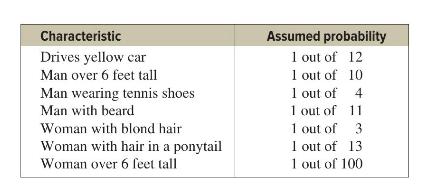In July 1964, an elderly woman was mugged in Costa Mesa, California. In the vicinity of the
Question:
In July 1964, an elderly woman was mugged in Costa Mesa, California. In the vicinity of the crime a tall, bearded man sat waiting in a yellow car. Shortly after the crime was committed, a young, tall woman, wearing her blond hair in a ponytail, was seen running from the scene of the crime and getting into the car, which sped off. The police broadcast a description of the suspected muggers. Soon afterward, a couple fitting the description was arrested and convicted of the crime. Although the evidence in the case was largely circumstantial, the two people arrested were nonetheless convicted of the crime. The prosecutor based his entire case on basic probability theory, showing the unlikeness of another couple being in that area while having all the same characteristics that the elderly woman described. The following probabilities were used.
1. Compute the probability of another couple being in that area with the same characteristics.
2. Would you use the addition or multiplication rule? Why?
3. Are the characteristics independent or dependent?
4. How are the computations affected by the assumption of independence or dependence?
5. Should any court case be based solely on probabilities?
6. Would you convict the couple who was arrested even if there were no eyewitnesses?
7. Comment on why in today's justice system no person can be convicted solely on the results of probabilities.
8. In actuality, aren't most court cases based on uncalculated probabilities?
Step by Step Answer:

Elementary Statistics A Step By Step Approach
ISBN: 9781260360653
11th Edition
Authors: Allan Bluman





